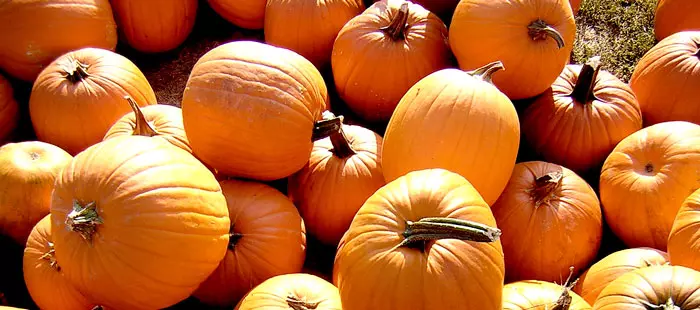Pumpkin can be eaten in a thousand ways: raw, lightly steamed, boiled, braised, baked … And it allows you to make countless dishes: grated raw as a salad ingredient, chunks in a soup, passed through the blender to make a cream, an ingredient in a stew or a dessert, and you can even make a shake that is in the recipes section of this article.
Remember that if you want to avoid losing vitamin C, the best way is to steam it for a maximum of fifteen minutes.
How to peel the pumpkin and not die trying
Some people do not eat pumpkin because they are lazy to peel it with a peeler or knife; the skin is hard, and you have to use force.
A long time ago, thanks to my mother’s trick to peel the pumpkin, I discovered that it is unnecessary to expend energy on this task. If you scald whole for five minutes in boiling water, you will see how the skin jumps very quickly afterward.
What do we do with pumpkin seeds?
Pumpkin seeds are very nutritious: they contain many minerals and vitamins (especially vitamin E), so it is almost sacrilege to throw them away. There are several options:
They can be roasted and salted, but then some of the oils they contain are damaged.
Cook them with the steamed pumpkin pieces and then eat them, peeling them with your teeth; I prefer this option.
Germinate them; their flavor is a bit bitter, but it combines well in a salad. To see how to germinate, you can look at this article by Montse Vallory.
How do we get children to eat pumpkins?
One strategy for children to eat pumpkin is to use it as an ingredient in a pasta sauce.
Make a healthy onion sauce following the instructions of our chef Montse Vallory and add the diced pumpkin.
When it is very soft, it is passed through the blender, and oregano is added.
Even a scientific article shows that if we want to encourage children to consume more vegetables, a trick is to add vegetable-based starters (strips, pieces, etc.) at each meal and add them as a sauce in dishes that allow it.
A pumpkin smoothie will delight the little ones in the house. It is a very nutritious, filling, and full of antioxidants breakfast.
Organic, seasonal, and seasonal pumpkin
Dr. M. Dolores Raigon presents the results of comparing conventional and organically grown pumpkins, and it is clear that organic pumpkins are nutritionally superior (52% more carotenoids, 60% more potassium and copper, 13% more zinc). Besides, it must be borne in mind that ecology is the only way to ensure that pesticides or synthetic fertilizers are not used in the crop.
Furthermore, pumpkin cultivation is used for soil decontamination precisely because it can absorb heavy metals and polycyclic aromatic hydrocarbons and radioactivity from the soil; therefore, we are interested in acquiring pumpkins grown in soils fertilized only with organic marinade.
The only way to be sure is to buy organic since in conventional cultivation, and artificial fertilizers are used, organic marinades from slurry from intensively raised animal farms, composed of urban organic waste, among other not recommended sources.
Organic pumpkins grown with the organic system have a sweeter and more intense flavor and a softer texture. This is what the organic producer David Moncunill tells it, who sells to different organic restaurants precisely because chefs know how to appreciate its superior organoleptic value.
The organicity system has to do with how the earth is treated so that it is a living being, with several interactions between the inhabitants (microorganisms, fungi, insects, worms), which help to fix the nutrients so that they are available so that the plant absorbs them better and results in a superior flavor and texture.
Pumpkin recipe with spicy tahini sauce by Cristina Arroyo
Benefits of zucchini
Benefits of zucchini (Photo: Getty Images)
First, 90% of its weight is water, so it is low in calories. Ideal for the diet!
½ cup of zucchini contains more than 1 gram of fiber.
It is an essential source of potassium, so it helps control blood pressure by lowering sodium in the blood; it is ideal for people with hypertension.
Source of iron, ideal to be consumed by children and young women.
It is rich in vitamin C and A, especially in carotenes, zeaxanthin, and lutein, which function as antioxidants protecting the cell membrane, encouraging aging, and preventing diseases by detecting free radicals.
It has no fat or calories.
It also helps to stimulate the immune system preventing colds and the onset n of kidney stones.
Strengthens bones and teeth.
It helps you keep your skin healthy.
In addition, it is advisable to eat it with everything and skin since most of its antioxidants and fiber are found in it.
Finally, it is rich in B complex vitamins, folate, B6, B1, B2, B3, and choline and minerals such as iron, manganese, and phosphorus.
There is an excellent variety of pumpkin species, but, among the best known, in the first place we find:
The famous pumpkin Cucurbita maxima, which is better known as the Halloween pumpkin
Mustache: The pumpkin flower is extracted; its shape is very similar to that of a peanut; its shell is smooth and orange.
Pepo: it is better identified as zucchini, zucchini, or zucchini, which is identified by having a tone that goes from green to yellow and having an elongated or round shape.
Argyrosperma: it has an oval shape and is commonly known as pipiana; Of this, its seed is usually used more since it has a high content of oil and protein used to make sauces such as pipián.
Ficifolia: it is commonly known as chilacayote; This pumpkin is usually confused with the pepo because of its color, since, when it is tender, it measures 6 to 12 cm, but, when ripe, it usually reaches 20 or 25 cm.





